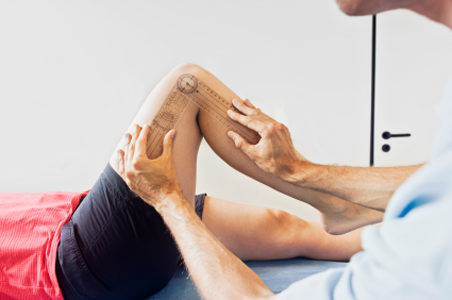Have you ever wondered what knee arthritis was or were concerned about it? If that is the case, let us review some of the basics.
What is knee arthritis?
It can also be called osteoarthritis or degenerative joint disease. It results from wear and tear that leads to progressive of loss of the knee cartilage. The wear and tear comes from:
- the release of enzymes in the knee joint.
- and prolonged, repetitive, and/or awkward forces on the knee joint.
This loss of cartilage, which is normally smooth, creates a rough surface. With repetitive motion the increased friction from the bones gliding past each other causes swelling and pain. Over time it can also cause increased bone formation called bone spurs or osteophytes.
How does knee arthritis feel?
Typically, it includes a gradual onset of knee pain that is worse with activity. There can also be a feeling of knee stiffness and pain after prolonged rest that worsens over time. The pain that is felt can either come from the bone itself, the soft tissue surrounding it, inflammation or muscle spasms. In addition to this, the knee may also lock or give out.
What causes knee arthritis
What causes this condition can be divided into two different categories: primary and secondary. Primary knee osteoarthritis is due to degeneration of the cartilage with no specific underlying reason. Secondary knee osteoarthritis is due to factor such as a previous knee injury, improper alignment of the knees, or diseases such as rheumatoid arthritis.
How to treat knee arthritis?
Often the first line of defence is exercise. It may seem a bit counterintuitive, but the prescription of exercises can go a long way in minimizing the effects of knee arthritis. Working with a physiotherapist can allow you to identify any abnormal knee movement, and correct any structures that might be tight or weak, affecting this movement. The physiotherapist can then give you proper stretches and strengthening exercises to reduce the pain and increase your function. Activity modification will also prevent excess stress on the knee joint, to allow you to do the activities you love with less risk of injury. Weight loss is also beneficial at any stage of the knee arthritis process. The use of NSAID’s, or non steroidal anti-inflammatory drugs, have also been showed to help with management, but should never be used without the other strategies outlined above.
Will knee arthritis get worse?
As we age, and as there is increase stress put on the knee over time, arthritis can progress. The first line of defence is being educated about your condition and what strategies (i.e. exercise and weight loss) you can do to prevent the progression of the condition. Of note, it has been found that the benefits are lost after 6 months if the exercises are stopped. If the knee arthritis continues to progress, corrective surgeries or knee replacements may need to take place.
Click Here to read more
What exercises help?
Exercise prescription should be individualized for each person to see what works for them. A physiotherapist can observe your knee alignment, ability to walk, squat, along with your knee range of motion and strength, then prescribe exercises to correct for any abnormalities. There can even be areas further from the knee, such as the foot, hip or low back, that need to be addressed. Through this assessment, a home exercise program can be designed to then manage and slow the progression of knee arthritis.
To book in with a physiotherapist for knee pain prevention or treatment click here.

